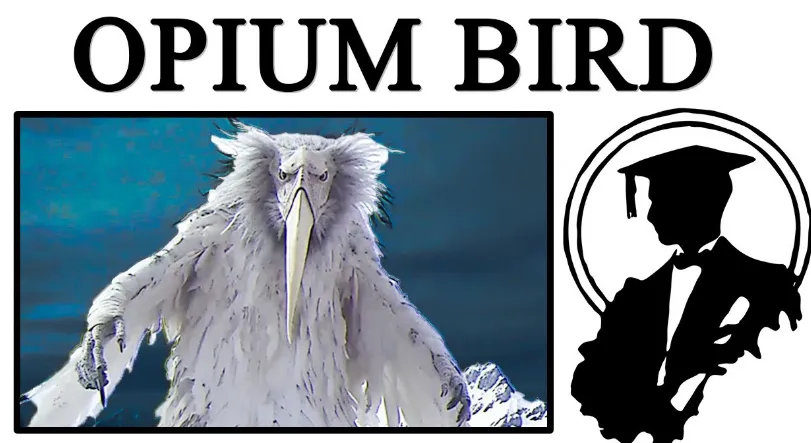The Opium Bird is a mythical creature that is not based on any real animal found in Antarctica. No bird by this name exists in scientific records.
Antarctica, the southernmost continent, has extreme conditions and unique wildlife. Penguins, seals, and various seabirds thrive in this icy environment. Known for its vast ice sheets and frigid temperatures, it remains one of the most unexplored regions on Earth.
Researchers and explorers continually discover new aspects of Antarctica’s ecosystem. Despite harsh conditions, it supports a surprisingly diverse range of life. The absence of the so-called Opium Bird highlights the importance of distinguishing between myth and reality. Understanding Antarctica’s true inhabitants helps preserve its delicate and unique ecosystem.
The Enigma Of Opium Bird
The Opium Bird of Antarctica is one of the most mysterious creatures on the planet. Many legends surround this elusive bird, and scientists and adventurers have long been fascinated by its unique characteristics.
Origins Of The Myth
The myth of the Opium Bird dates back centuries. Early explorers reported sightings of a strange, beautiful bird in the icy landscape of Antarctica. These stories quickly spread, captivating the imaginations of many.
Some believed the bird had magical powers, while others thought it was a symbol of purity and mystery. These tales have been passed down through generations, adding layers to the legend.
| Year | Event |
| 1800s | First reported sightings by explorers. |
| 1900s | Myth gains popularity in literature. |
| 2000s | Increased interest from scientists. |
Characteristics And Descriptions
The Opium Bird is known for its vivid plumage. Its feathers shimmer in shades of blue and green. This makes it easily distinguishable from other birds.
Witnesses describe the bird’s melodious call as echoing through the icy plains. It is said to be both haunting and beautiful.
- Size: Medium, similar to a seagull.
- Colour: Blue and green shimmering feathers.
- Sound: Melodious and haunting call.
Despite its striking appearance, the Opium Bird remains elusive. Few have managed to capture it on camera. This adds to its mystique and allure.
Scientists continue to study reports and sightings. They hope to learn more about this enigmatic creature.
Antarctica’s Unique Ecosystem
Antarctica’s ecosystem is one of the most unique on Earth. It is a cold, isolated land of ice and snow. Despite these harsh conditions, life thrives here. The Opium Bird is one of the many fascinating inhabitants. Let’s explore how life survives in this icy wilderness.
Harsh Climate And Inhabitants
Antarctica has one of the harshest climates on the planet. Temperatures can drop below -80°C and the continent is covered with ice and snow all year round.
Despite these conditions, many animals have adapted to survive. These include penguins, seals, and the Opium Bird. These creatures face extreme cold and intense winds.
Adaptations For Survival
Animals in Antarctica have developed unique adaptations. These help them survive the extreme cold and limited food resources.
- Thick Fur and Blubber: Seals and whales have thick layers of fat. This keeps them warm in icy waters.
- Feathers and Fat: Penguins have dense feathers and a layer of fat. This insulation helps them stay warm.
- Specialized Feeding Habits: Many birds and seals feed on krill and fish. They have adapted to find food in the cold waters.
The Opium Bird also has unique features. It has a thick layer of feathers and can slow its metabolism, which helps it conserve energy during long, cold winters.
Historical Sightings And Accounts
The Opium Bird of Antarctica has intrigued historians and bird watchers alike. Although its sightings are rare, they have left a significant mark on the history of exploration. This section explores various historical sightings and accounts related to this mysterious bird.
Early Explorers’ Encounters
Early explorers in Antarctica were often met with harsh conditions. Some reported sightings of a strange bird among the icebergs and freezing temperatures.
In 1820, a Russian expedition led by Fabian Gottlieb von Bellingshausen documented a sighting. The bird was described as having vibrant plumage and an unusual call.
Another account, in 1840, by a French explorer, Jules Dumont d’Urville, mentioned a similar bird. His crew noted its distinctive flight pattern and behaviour.
These early encounters sparked curiosity and led to further expeditions. Each explorer hoped to catch a glimpse of the elusive Opium Bird.
Tales From Indigenous Peoples
Indigenous peoples of the Antarctic region have their own stories about the Opium Bird, which have been passed down through generations.
One legend speaks of the bird as a guardian spirit. It is said to protect the land and its people from harm.
Another tale describes the bird as a harbinger of change. Its appearance is believed to signal significant events or shifts in the environment.
These stories highlight the bird’s cultural significance and mysterious nature, adding a rich layer to the historical accounts of the Opium Bird.
| Year | Explorer | Description |
| 1820 | Fabian Gottlieb von Bellingshausen | Vibrant plumage, unusual call |
| 1840 | Jules Dumont d’Urville | Distinctive flight pattern, unique behaviour |
These historical sightings and accounts provide a fascinating glimpse into the world of the Opium Bird. They reveal the bird’s impact on explorers and indigenous cultures alike.
Scientific Expeditions And Research
For decades, scientists have been fascinated by the quest to find the mysterious Opium Bird in Antarctica. Numerous scientific expeditions and research projects have been launched to uncover the secrets of this elusive bird. These efforts have provided valuable insights into the region’s unique ecosystem and the possible existence of the Opium Bird.
Modern Searches For The Bird
Modern searches employ advanced technology. Researchers use satellite imagery and drone surveillance to scan vast areas. Scientists also rely on bioacoustic monitoring to capture bird calls, which helps identify the Opium Bird’s unique sound patterns.
Ground teams collect feathers and droppings for DNA analysis, which confirms the bird’s presence in specific locations. Collaboration with international teams ensures a diverse set of skills and tools, which increases the chances of finding the Opium Bird.
Evidence And Theories
Several pieces of evidence suggest the Opium Bird’s existence. Below is a table summarizing key findings:
| Evidence | Description |
| DNA Samples | Unique genetic markers found in droppings. |
| Feather Analysis | Distinct feather patterns are different from known species. |
| Audio Recordings | Unusual bird calls recorded in remote areas. |
Several theories exist about the Opium Bird’s habitat and behaviour:
- Habitat Theory: The bird lives in isolated, icy caves.
- Migratory Patterns: It migrates seasonally to avoid harsh weather.
- Dietary Habits: Feeds on specific Antarctic insects and plants.
Understanding these theories helps in planning future expeditions. Each research project builds on previous knowledge. This brings us closer to uncovering the truth about the Opium Bird.
Cultural Impact Of The Opium Bird
The Opium Bird of Antarctica has captivated human imagination for centuries. This mysterious avian has woven its way into various facets of culture, leaving a lasting imprint. From folklore to modern media, the Opium Bird’s influence is profound and fascinating.
Folklore And Art
In ancient Antarctic tribes, the Opium Bird symbolized mystery and dreams. Legends often depicted the bird as a bridge between the natural and dream worlds. Artefacts from these tribes show intricate carvings and paintings of the Opium Bird, highlighting its significance.
Artists worldwide have drawn inspiration from this enigmatic creature. Many paintings showcase the bird in surreal landscapes, emphasizing its otherworldly charm. Sculptures and murals also celebrate its majesty, making the Opium Bird a recurring motif in various art forms.
Influence On Literature And Film
The Opium Bird has also left its mark on literature. Numerous authors have woven tales around this intriguing bird. In some stories, it serves as a harbinger of dreams and prophecies. In others, it plays a central role in mystical adventures.
In modern cinema, the Opium Bird features in several movies. Filmmakers use its mystical aura to add depth to their narratives. Documentaries about Antarctica often highlight the bird, adding a layer of enchantment to the factual content.
| Medium | Representation of Opium Bird |
| Folklore | Symbol of mystery and dreams |
| Art | Subject in paintings and sculptures |
| Literature | A central role in mystical tales |
| Film | Featured in movies and documentaries |
The cultural impact of the Opium Bird extends far beyond its Antarctic origins. This bird inspires and fascinates, leaving an indelible mark on human creativity.
Conservation And Environmental Concerns
The Opium Bird of Antarctica is a mystical creature that intrigues many. Yet, its existence is threatened by numerous environmental concerns. This section delves into the efforts to conserve this unique bird and the impacts of climate change on its habitat.
Protecting Antarctica’s Biodiversity
Antarctica’s biodiversity is unique and fragile. The Opium Bird, like many other species, relies on a delicate ecosystem, so protecting this biodiversity is crucial.
- Strict regulations govern human activities in Antarctica.
- Protected areas are established to shield habitats from disturbance.
- Scientific research is prioritized to understand and preserve wildlife.
These measures help maintain the balance for species like the Opium Bird to thrive.
Impact Of Climate Change On Mythical Species
Climate change poses a significant threat to the Opium Bird. Rising temperatures affect the ice caps and the environment.
- Ice melting reduces the bird’s natural habitat.
- Changing weather patterns disrupt breeding cycles.
- Food scarcity arises as prey species decline.
Addressing climate change is essential to ensure the survival of this mythical species.
Technological Advances In Exploration
Opium Bird Antarctica has seen tremendous progress due to technological advances. Scientists use cutting-edge tools to study this remote region, and these tools help gather valuable data with precision and efficiency. Let’s explore some of these exciting technologies.
Satellites And Drones
Satellites and drones provide aerial views of vast areas. These tools allow scientists to monitor wildlife patterns and environmental changes. High-resolution satellite images help track climate changes and glacier movements.
Drones offer a closer look at difficult-to-reach areas. They capture detailed images and videos, helping researchers study the habitat of the Opium Bird. Drones can also carry sensors to measure temperature, humidity, and other vital data.
DNA Analysis And Genetic Studies
DNA analysis plays a crucial role in understanding the Opium Bird. Researchers collect DNA samples to study the bird’s genetic makeup, which helps identify genetic variations and study its evolutionary history.
Genetic studies also help in conservation efforts. Scientists can identify genetic diversity within the species. This information is vital for developing strategies to protect the Opium Bird from extinction.
| Technology | Purpose |
| Satellites | Monitoring climate and glaciers |
| Drones | Capturing detailed images and videos |
| DNA Analysis | Studying genetic makeup |
| Genetic Studies | Conservation efforts |
The Future Of The Opium Bird Mystery
The Opium Bird of Antarctica remains a tantalizing enigma. Recent discoveries hint at answers, and enthusiasts and scientists eagerly await new findings. The future holds many possibilities. Let’s explore the ongoing quest and its potential impact.
Continuing The Quest
Researchers are committed to unlocking the mystery of the Opium Bird. They use advanced technology and innovative methods. Drones and satellite imagery help locate these elusive birds, and expeditions are planned to gather more data.
Citizen scientists also play a crucial role. Enthusiasts share sightings and observations, accelerating discovery through this collective effort. Educational programs raise awareness and inspire young minds.
Collaboration is key. International teams share knowledge and resources. This global effort drives progress. Every discovery brings us closer to understanding the Opium Bird.
What Discovery Would Mean For Science
Uncovering the secrets of the Opium Bird would revolutionize science. It could provide insights into bird migration patterns. Understanding their behaviour could aid conservation efforts.
Discoveries might reveal new species, expanding our knowledge of biodiversity. The Opium Bird could become a symbol of scientific curiosity and perseverance.
The data collected could benefit many fields. Climate scientists may use it to study environmental changes, and ecologists might find new ways to protect habitats. The potential impact is vast and far-reaching.
| Impact | Field |
| Migration Patterns | Ornithology |
| New Species | Biodiversity |
| Conservation Efforts | Ecology |
| Environmental Changes | Climate Science |
The Opium Bird mystery continues to inspire. The journey to uncover its secrets is a testament to human curiosity and dedication. The future holds exciting possibilities for discovery and learning.
Conclusion
Discovering the opium bird in Antarctica offers a unique glimpse into nature’s wonders. This rare sighting enriches our understanding of avian life in extreme climates. Stay curious and keep exploring the hidden secrets of our world. Every discovery adds to our appreciation of Earth’s biodiversity.
>>You may check also:




